
Official Edgar Rice Burroughs Tribute Site Since 1996 ~ Over 15,000 Webpages and Webzines in Archive Volume 1154 |

Official Edgar Rice Burroughs Tribute Site Since 1996 ~ Over 15,000 Webpages and Webzines in Archive Volume 1154 |
![]()
ERB References for the
THE APACHE NOVELS II
The War Chief ~ The Apache
Devil
![]()
Source: The
ERB Personal Library Collection
![]()
|
SOURCES OF BACKGROUND INFORMATION IN ERB'S APACHE NOVELS Burroughs drew upon his personal experiences from when he served as a trooper with the U.S. 7th Cavalry at Fort Grant, Arizona. He also cited the following books
and periodicals
The Marvellous Country: Three Years in Arizona and New Mexico, the Apache's Home by Samuel Woodworth Cozzens 1873 |
|
|
| Geronimo's Story of His Life ~ 1906 ~ NY: Duffield ? Co.~ T
he soul, rituals and history of the Apache people told in the words of
Geronimo to S.M. Barrett and published in 1906. This story is a sterling
example of the valiant but losing battle First Nations cultures fought
against the seemingly unstoppable European way of life.
This was one of the books ERB used to gather background information for his Apache novels. Online eText Edition Cited by ERB as reference material for his Apache novels  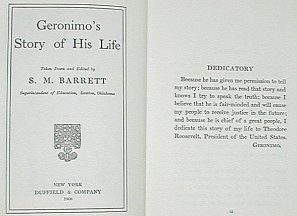
|
| S.M. Barrett: During 1905 and 1906, Geronimo, the legendary Apache warrior and honorary war chief, dictated his story through a native interpreter to S.M. Barrett, then superintendent of schools in Lawton, Oklahoma. As Geronimo was by then a prisoner of war, Barrett had made appeals all the way up the chain of command to President Teddy Roosevelt for permission to record the words of the "Indian outlaw." Geronimo came to each interview knowing exactly what he wanted to cover, beginning with the telling of the Apache creation story. When, at the end of the first session, Barrett posed a question, the only answer he received was a pronouncement-"Write what I have spoken." |
|
|
| Trailing Geronimo: The Outbreak of the White Mountain Apaches, 1881
- 1886 ~ 1926 ~ Mazzanovich was with Troop F. 6th U.S. Cavalry
~ A book cited by ERB as a research source for his Apache novels. Some
hitherto unrecorded incidents bearing upon the outbreak of the White mountain
Apaches and Geronimo's band in Arizona and New Mexico.
Online Version with scanned pages ~ Many great photos: Arizona Apaches Cavalry http://www.1st-hand-history.org/TrG/album1.html The story of September 1886 and the surrender of the Chiricahua Apache Geronimo. Marking the end of centuries of warfare between European-Americans and the desert Indians in the southwestern United States and northern Mexico, Geronimo's surrender is recorded here. This is an account of the struggle by a soldier who was there, up to and including the final scene in Skeleton Canyon. 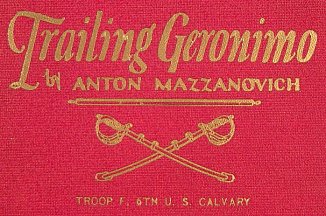 |
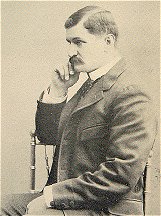 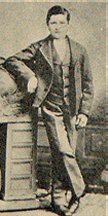 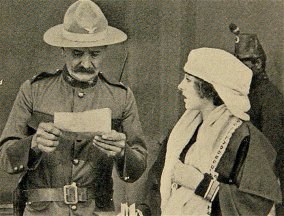
Anton Mazzanovich and Winnifred Kingston in the film The Light of Western Stars by Zane Grey 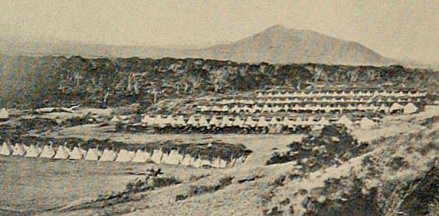
Anton Mazzonovich Cavalry Camp on the Bank of the Gila 1881 ~ Near Fort Thomas
Veterans of Indian Wars |
|
|
| Life Among the Apaches
1868
A first-hand account of John C. Cremony's personal adventures with Apache indians in the latter part of the 19th century, in particular the Chiricahua Apaches. Although this effort's original purpose was to induce more effective military suppression of the Apaches (it was first published in 1868), it has all of the fast-paced action and excitement of a novel and the authenticity of an ethnographic and historical document. It is informative about Apache beliefs, tribal life, and fighting tactics. Online Edition in PDF: http://www.pdflibrary.com/Samples/AMERICAN_INDIANS/1582183864.pdf Online Sample in HTML |
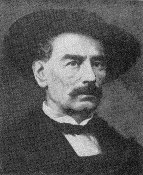 Cremony's book
inspired many a Hollywood screenwriter, and for years his words have been
taken as gospel. Scholars have since shown that Cremony was habitually
inflating his own importance and his knowledge of Apache ways and history.
Of particular note are his highly fictionalized accounts of the life of
Mangas Coloradas -- a man far more important to history than Cremony. But
this work remains an extremely telling document of a time and place --
and all the strange attitudes that made up "white" perceptions. It is a
refreshingly open and objective look at the Apache culture before the reservations.
Cremony wrote the first dictionary of the Apache language and earned their
grudging respect. He shows admiration for their amazing courage, endurance,
and skills of warfare and survival. But, since this was written a century
before the political correctness Victorianism we now are censored by, Cremony
is able to share his concerns about their interesting work ethic (it is
dishonorable for a man to work besides hunting and stealing) and their
cruelty. Cremony makes some polite comments about the extreme attractiveness
of some of the Apache women which suggests, at a minimum, an emotional
involvement -- which adds a touching romantic side to this well written
account. Cremony's book
inspired many a Hollywood screenwriter, and for years his words have been
taken as gospel. Scholars have since shown that Cremony was habitually
inflating his own importance and his knowledge of Apache ways and history.
Of particular note are his highly fictionalized accounts of the life of
Mangas Coloradas -- a man far more important to history than Cremony. But
this work remains an extremely telling document of a time and place --
and all the strange attitudes that made up "white" perceptions. It is a
refreshingly open and objective look at the Apache culture before the reservations.
Cremony wrote the first dictionary of the Apache language and earned their
grudging respect. He shows admiration for their amazing courage, endurance,
and skills of warfare and survival. But, since this was written a century
before the political correctness Victorianism we now are censored by, Cremony
is able to share his concerns about their interesting work ethic (it is
dishonorable for a man to work besides hunting and stealing) and their
cruelty. Cremony makes some polite comments about the extreme attractiveness
of some of the Apache women which suggests, at a minimum, an emotional
involvement -- which adds a touching romantic side to this well written
account. |
|
|
| Apache Medicine-Men
Read the eText Classic of 19th-century anthropology covers role of medicine-men in treating disease, superstitions, paraphernalia, medicine-women, the use of tule pollen as sacrificial powder, clay-eating, sacred breads and cakes, the izze-kloth or medicine cord, medicine hat, spirit or ghost dance headdress, amulets and talismans, more. Also analogous objects, rites, ceremonies in other cultures. 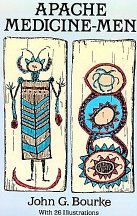
OTHER: On the Border With Crook ~ reprinted by Univ of Nebraska Pr (June 1971) John Bourke writes of General George Crook, a legendary Indian fighter in post-Civil War Arizona, Wyoming, and Montanna. Bourke, who for most of the time was Crook's aide-de-camp, is an unabashed admirer of the General, but the book goes far beyond flattery and sycophancy. Bourke makes the reader admire Crook as much as he himself does, for Crook truly did possess unmatched stamina, experience, attention to detail and equal measures of sympathy for the Indians he was fighting and ruthlessness in his ambition to drive them onto the reservations. Bourke too admires the Indians, especially the Apaches. In fact, one of the book's high points is its almost anthropological descriptions of Apache life, the Arizona landscape, life in the frontier Army, and the social milieu of old Tuscon. The descriptions of Crook's campaigns against the Sioux and Cheyenne flag just a little, but only in comparison to Bourke's own rapturous discussions of life in the Southwest. The book that this compares best to is Eugene Ware's "The Indian War of 1864" (which I've also reviewed for Amazon). Ware, like Bourke, was a serving Army officer with a keen, sympathetic eye for all he saw in the old West. Both were involved in more hair-raising episodes than a dozen Hollywood action heroes combined. I too am a serving Army officer, and I can testify that none of my peers today has seen as much or writes so well. The concept of Manifest Destiny took root during the Mexican American War, and assumed grander proportions following the Civil War. Gen. Crook had been a calvery officer whose services proved to be of considerable value, as much for his ability as for his compassion for the Indians. His job was to protect the settlers and subdue the Indians by locating them on reservations. The author was with Crook during his first and second Southwest campaigns as well as that of the Northern Plains. His love for his commander and appreciation of the Indians made him the perfect writer for the topic. Gen. Crook seems the ideal officer for the job, but was defeated, not by the Indians but Agents assigned, after the army had done its work, to reservations by Washington. The book is a wonderful description of the duty performed by Gen. Crook who, had his system been utilized, would have led to a better life for all. In the end, Bourke feels, Crook died of a broken heart. Important history, and a story too beautifully told to miss.
The Diaries of John Gregory Bourke: November 20, 1872, to July 28, 1876 ~ reprinted by University of North Texas Press (March 2003) Captain John G. Bourke's Influence on Edgar Rice Burroughs ERBzine 3482 Captain John Bourke's ON THE BORDER WITH CROOK and THE MEDICINE MEN OF THE APACHE Illustrations and Text from the First Editions Related Reference Links from ERBzine ERBzine 3483 |
|
Danton Burroughs found the following note with the manuscript for The War Chief: "I have gone over the 'copy' carefully and have indicated a number of phrases, sentences and paragraphs deleted by them, which I wish to have retained. The preparation of the manuscript required considerable research work and as it is necessary for the reader to be able to understand the viewpoint of the Indian, if he is to be in sympathy with the principal character, it is essential that much of the matter deleted should remain even though it draws comparisons that may be odious to some people of our own race and sometimes shocking to people whose religious convictions are particularly strong. I should also call your attention to an Indian name and an Indian word concerning which the magazine editor and I seem not to agree. The name is that of a famous Apache Chief, Mangas Colorado, variously spelled Mangus and Magnus. From a very old book I obtained the suggestion of the derivation of this name, which in Spanish means colored sleeves. The author supposed that the name may have been given to him by the Mexicans, either because of the garment he wore with colored sleeves or from the fact that his sleeves or arms were stained with the blood of his victims.
The magazine editor deleted what evidently appeared to him tiresome descriptions of Indian customs, such as burial ceremonies and the decoration of the bodies of medicine men, but as there is not a great of this and I believe that it is all based on good authority, it should be permitted to remain." |
|
FROM THE BURROUGHS PERSONAL LIBRARY |
|
"Annual Report of the Bureau of Ethnology" Indians of the Enchanted Desert by Leo Crane
Columbian
Exposition in Chicago 1893
Captain (General) Charles King www.ERBzine.com/king The ERB / Charles King Connection The Charles King Bibliography A good selection of books by Indian Fighter, MMA Commandant, and best-selling author: Cadet Days Christianity The True U.S. Grant Campaigning With Crook: Read King in ERBzine: Custer's Last Battle by Captain Charles King I Excerpts from the writings of Captain Charles King II More Excerpts from the writings of Captain Charles King III 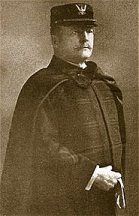
King was author of over 60 books and hundreds
of articles and short stories.
His novels, although they all follow virtually
the same plot, draw from personal experience and are exciting narratives
full of accurate, detailed descriptions of army life and Indian wars in
the American West.
Norton's American Indian Vol 1?2 by George Cackman ~ 1926 North American Indians (2 volumes) by Cathus North American Indians: Being Letters and Notes on Their Manners, Customs, and Conditions, Written During Eight Years Travel Amongst The Wildest Tribes of Indians in North America, 1832-1839. 2 volumes. by George Catlin ~ 1926. Indians of the Enchanted Desert by Leo Crane ~ 1925 |
|
|
|
Captain Bourke's Influence On the Border with Crook |
Text and Illustrations ERB References |
Scrapbook: Art and Photos Indian Wars and Apaches |
Apache 3-D Photos 28 Stereoviews |
|
ERB C.H.A.S.E.R.: THE WAR CHIEF ERB C.H.A.S.E.R.: APACHE DEVIL Robert "Tarak" Woodley Discusses The War Chief (an ERBapa reprint) ERB Time Line Bio |
![]()

![]()
![]()

![]()
BILL
HILLMAN
Visit
our thousands of other sites at:
BILL
AND SUE-ON HILLMAN ECLECTIC STUDIO
ERB
Text, ERB Images and Tarzan® are ©Edgar Rice Burroughs, Inc.-
All Rights Reserved.
All
Original Work ©1996-2004/2012/2018 by Bill Hillman and/or Contributing
Authors/Owners
No
part of this web site may be reproduced without permission from the respective
owners.